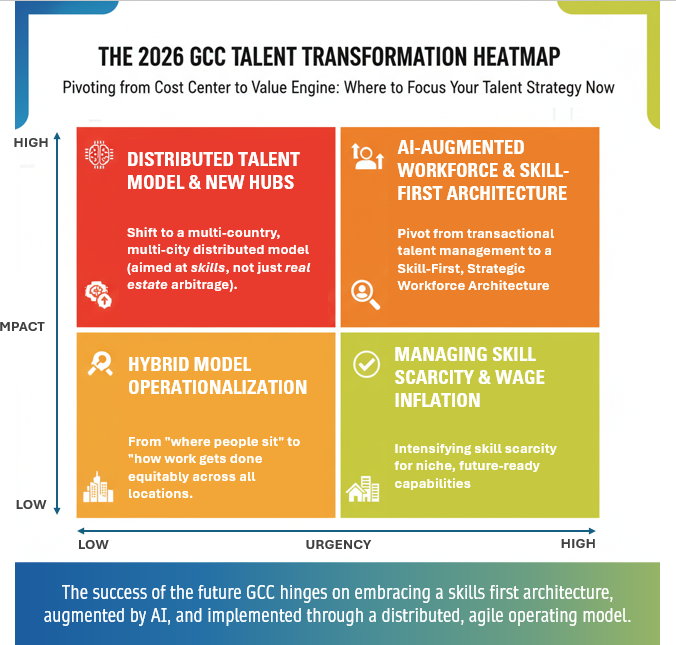Global Talent Trends for GCCs in 2026
The Global Capability Center (GCC) model is undergoing its most profound strategic transformation yet. It is no longer seen as cost centers, GCCs are transforming into value-creation engines, leading innovation, digital transformation, and business resilience for their parent companies.
This evolution is being tested by unprecedented volatility in the global talent market, rapid advancements in Artificial Intelligence (AI) and a fundamental shift in employee expectations. For GCC leadership, 2026 requires a pivot from transactional talent management to a skill-first, strategic workforce architecture.

Skills Scarcity
The foundational challenge facing GCCs is an intensifying skill gap. While most of the available workforce remains vast, the availability of niche, future-ready capabilities required to power next-generation centers is extremely difficult. This disparity is driving wage inflation and increasing the cost of replacement hiring across established hubs.
Critical Roles and Gaps
The most pressing talent gaps are concentrated in roles critical to a GCC’s transition from a service enabler to a product owner:
- The growing demand for professionals skilled in applying Generative AI (GenAI) to enterprise functions like software development, legal analysis, and customer service is reshaping talent needs.
- The shift to hybrid, multi-cloud environments requires deep expertise in zero-trust architecture, cloud governance, and specialized security frameworks.
- As GCCs take on end-to-end product ownership, the demand for product managers with worldwide domain knowledge and user-centric design capabilities is increasing.
- Organizations require professionals who can deploy agile at scale across distributed, cross-functional teams, moving beyond basic Scrum to more adaptive and flexible operating systems.
To counter this, forward-thinking GCCs are shifting their focus from “buying” talent to “build, borrow, and bot” approach. This involves aggressive internal upskilling, utilizing the contingent workforce, and integrating automation to reduce dependence on repetitive roles.
AI and Productivity
Artificial Intelligence will be the defining force in workforce strategy for 2026: driving productivity in augmented roles while necessitating a fundamental redesign of workflows to enable seamless human-AI collaboration. The core strategic shift lies in positioning AI not merely as an efficiency enabler, but as a co-pilot for innovation.
AI-Assisted Engineering
Engineering roles in GCCs are being rapidly redefined to meet evolving business needs. AI-aided engineering shifts the focus from writing boilerplate code to strategic problem solving, system design, and fast engineering.
- GenAI tools are now able to generate up to 40% of standard code and handle initial testing, allowing engineers to focus on complex design, architecture, and IP development.
- GCCs must train their talent to “reason with AI”: using AI co-pilots effectively, debugging outputs, and understanding biases and ethical implications.
- Success metrics are shifting from lines of code to provide velocity, defect reduction, and faster time-to-market.
- The future GCC engineer is a digital craftsman augmented with intelligent tools.
Distributed Teams
The old model of large, centrally located GCCs based on in-office presence is dismantled by employee demand and the need for talent management. The current trend is toward a multi-country, multi-city distributed model, aimed at skills, not real estate arbitrage.
Hybrid Operating Models
A successful hybrid operating model for a GCC is not a mere schedule; it is a comprehensive framework that governs asynchronous collaboration, cultural integration, and technology parity across locations.
To build effective hybrid work models, companies can begin by:
- Redefining work by task and context: Identify which activities require in-person collaboration: such as brainstorming, onboarding, client workshops, and complex problem-solving and which are better suited for remote execution, including deep work, coding, analytics, and documentation.
- Ensuring equity across locations: Create policies and practices that provide equal visibility, leadership access, and career growth opportunities for remote, in-office, and satellite teams. This helps prevent the emergence of a two-tier workforce.
- Strengthening digital infrastructure: Invest in secure, intuitive, and interoperable digital tools that facilitate seamless communication, real-time collaboration, and knowledge sharing across dispersed teams.
- Adopting a flexible talent model: Move towards a skill-based workforce strategy that allows for dynamic deployment of talent across geographies, projects, and functions. This ensures agility while leveraging global expertise.
- Embedding cultural cohesion: Foster a shared culture through intentional rituals, inclusive leadership practices, and hybrid-friendly engagement initiatives that strengthen belonging and collaboration across distributed teams.
New Talent Hubs
Talent diversification is becoming a critical risk mitigation strategy against concentration risk in traditional Tier-1 hubs, which pose high attrition and highly competitive costs of talent acquisition.
Ecosystem Drivers
The search for new GCC locations is not solely about cost arbitrage; it is about accessing untapped, specialized talent pools and creating resilient, interconnected ecosystems.
- GCCs are expanding into Tier-2 and Tier-3 cities, achieving 40–60% cost efficiency, a growing talent pipeline, and a more secure workforce.
- Enterprises are constructing smaller, high-impact hubs in regions such as Eastern Europe, Latin America, and Southeast Asia to enable a hub-and-spoke model, providing 24/7 coverage and geopolitical risk diversification.
- Success depends on deep local integration partnering with universities to co-create talent pipelines.
GCC Strategy Roadmaps
GCC leaders must transform these trends into an actionable blueprint that affirms their status as strategic innovation platforms.
12–24-Month Roadmap
The next 12 to 24 months require a decisive roadmap on agility, skill augmentation, and distribution.
Strategic Pillar | 12-Month Focus (Foundation & Acceleration) | 12–24-Month Focus (Scale & Resilience) |
Talent & Skills |
|
|
AI & Workflows |
|
|
Location Strategy |
|
|
By creating an agile, skilled workforce and strategically deploying AI and distributed operating models, GCCs can ensure that they are not only surviving the talent revolution but leading their businesses to new competitive levels.
Conclusion
The next 12 to 24 months present a crucial window for GCC leaders to shift from operational efficiency to strategic resilience. The success of the future GCC hinges on embracing a skills-first architecture, augmented by AI, and implemented through a distributed, agile operating model. This transformation is not optional it is the direct path to sustaining competitive advantage
To accelerate your transition from a capability center to a strategic value engine, partner with ANSR today to define and execute your Skills-First 2026 GCC Roadmap.




